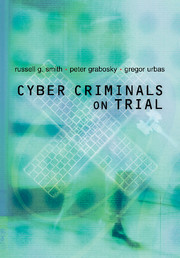Book contents
- Frontmatter
- Contents
- List of figures and tables
- Acknowledgments
- Preface
- Abbreviations
- Currency exchange rates
- Chapter One Introduction
- Chapter Two Defining and Measuring Cyber Crime
- Chapter Three The Prosecutor as Gatekeeper
- Chapter Four Cross-Border Issues
- Chapter Five Strategies of Cyber Crime Litigation
- Chapter Six The Quest for Harmonisation of Cyber Crime Laws
- Chapter Seven Judicial Punishment in Cyberspace
- Chapter Eight Sentencing Cyber Criminals
- Chapter Nine Conclusions
- References
- Appendix A Case Summaries 1972–2003
- Appendix B Selected Legislative Summaries
- Index
Chapter Two - Defining and Measuring Cyber Crime
Published online by Cambridge University Press: 22 September 2009
- Frontmatter
- Contents
- List of figures and tables
- Acknowledgments
- Preface
- Abbreviations
- Currency exchange rates
- Chapter One Introduction
- Chapter Two Defining and Measuring Cyber Crime
- Chapter Three The Prosecutor as Gatekeeper
- Chapter Four Cross-Border Issues
- Chapter Five Strategies of Cyber Crime Litigation
- Chapter Six The Quest for Harmonisation of Cyber Crime Laws
- Chapter Seven Judicial Punishment in Cyberspace
- Chapter Eight Sentencing Cyber Criminals
- Chapter Nine Conclusions
- References
- Appendix A Case Summaries 1972–2003
- Appendix B Selected Legislative Summaries
- Index
Summary
Before proceeding with our substantive discussion it is important to examine the definition, nature and scope of cyber crime, in order to delimit our inquiry as well as to place the discussion of the cases we have chosen for analysis in some theoretical context. In the following discussion we shall examine some of the key terms and their relationship to other descriptive categories of crime that overlap to some extent with our topic of inquiry.
Clearly, digital technologies lie at the heart of cyber crime and these include computers, communication technologies and networked services. Grabosky and Smith (1998) describe the wide range of services included within the concept of digital technologies and for the purposes of the present discussion we shall assume that computers, communications technologies and other networked services form the infrastructure in which cyber crime may be committed. References to computers and digital technologies will be used interchangeably.
Cyber Crime Not Cybrecrime
There is, at present, a wide range of adjectives used to describe computer crime – virtual, online, cyber-, digital, high-tech, computer-related, Internet-related, telecommunications-related, computer-assisted, electronic, and ‘e-’ (as in ‘e-crime’). In the same way that the term ‘white collar crime’ sparked fifty years of discussion and controversy, these terms coined to delimit the scope of computer-related misconduct are likely to be similarly problematic.
For present purposes we have chosen to adopt the term ‘cyber crime’ to describe our subject matter, although any of the other terms could justifiably have been chosen.
- Type
- Chapter
- Information
- Cyber Criminals on Trial , pp. 5 - 30Publisher: Cambridge University PressPrint publication year: 2004



